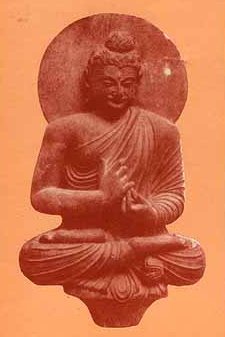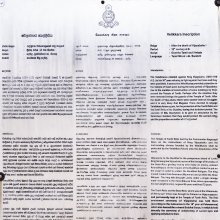Suriya, Sūriya: 10 definitions
Introduction:
Suriya means something in Buddhism, Pali, Hinduism, Sanskrit, Marathi, biology. If you want to know the exact meaning, history, etymology or English translation of this term then check out the descriptions on this page. Add your comment or reference to a book if you want to contribute to this summary article.
Images (photo gallery)
In Buddhism
Theravada (major branch of Buddhism)
Source: Pali Kanon: Pali Proper Names1. Suriya. A Devaputta. Once, when he was seized by Rahu, lord of the Asuras, he invoked the power of the Buddha, and the Buddha enjoined on Rahu to let him go. This Rahu did, and Suriya is spoken of as seeking Vepacitti and standing by his side, trembling and with stiffened hair (S.i.51; cf. Candima). Suriya is one of the inhabitants of the Catummaharajika world (MNidA.108). Suriya and Candima are both under the rule of Sakka, and we find Sakka asking them to stop their journeying at his behest. (E.g., when he wished the Samaneras Pandita and Sukha to be able to meditate undisturbed (DhA.ii.143; iii.97). See also DhA.iii.208).
Suriya was present at the preaching of the Mahasamaya Sutta (D.ii.260). He is sometimes (PSA. 253) described as Adicca (Aditis son). The disk of the sun, which forms Suriyas vimana, is fifty leagues in diameter (E.g., D.iii.196).
2. Suriya. A son of Sakka (q.v.).
Theravāda is a major branch of Buddhism having the the Pali canon (tipitaka) as their canonical literature, which includes the vinaya-pitaka (monastic rules), the sutta-pitaka (Buddhist sermons) and the abhidhamma-pitaka (philosophy and psychology).
Biology (plants and animals)
Source: Wisdom Library: Local Names of Plants and DrugsSuriya [सुरिया] in the Marathi language is the name of a plant identified with Xylia xylocarpa (Roxb.)Taub. from the Mimosaceae (Touch-me-not) family having the following synonyms: Mimosa xylocarpa, Xylia dolabriformis. For the possible medicinal usage of suriya, you can check this page for potential sources and references, although be aware that any some or none of the side-effects may not be mentioned here, wether they be harmful or beneficial to health.
Source: Google Books: CRC World Dictionary (Regional names)1) Suriya in India is the name of a plant defined with Xylia xylocarpa in various botanical sources. This page contains potential references in Ayurveda, modern medicine, and other folk traditions or local practices It has the synonym Xylia xylocarpa Taub. (among others).
2) Suriya in Kenya is also identified with Cleome gynandra It has the synonym Pedicellaria pentaphylla Schrank (etc.).
Example references for further research on medicinal uses or toxicity (see latin names for full list):
· Flora de Filipinas (1837)
· Travels Through North and South Carolina (1791)
· Taxon (1980)
· Bijdragen tot de flora van Nederlandsch Indië (1825)
· Journal of Ethnopharmacology (2007)
· Hortus Britannicus (1827)
If you are looking for specific details regarding Suriya, for example side effects, pregnancy safety, chemical composition, diet and recipes, extract dosage, health benefits, have a look at these references.

This sections includes definitions from the five kingdoms of living things: Animals, Plants, Fungi, Protists and Monera. It will include both the official binomial nomenclature (scientific names usually in Latin) as well as regional spellings and variants.
Languages of India and abroad
Pali-English dictionary
Source: BuddhaSasana: Concise Pali-English Dictionarysuriya : (m.) the sun. || sūriya (m.), the sun.
Source: Sutta: The Pali Text Society's Pali-English DictionarySūriya, (nt.) (abstr. fr. sūra1) valour S. V, 227 (text, sūra); J. I, 282; Miln. 4. (Page 722)
— or —
Suriya, (Vedic sūrya cp. suvar light, heaven; Idg. *sāǔel, as in Gr. h(λios, Lat. sōl. , Goth. sauil sun; Oir. sūil “eye”; cp. also Gr. sέlas splendour, selήnh moon, & many others, for which see Walde, Lat. Wtb. s. v. sōl) 1. the sun Vin. I, 2; D. II, 319; Sn. 687; A. I, 227; S. V, 29 sq.; J. II, 73; Vism. 231 (in simile), 416 (the seventh sun), 417 (myth of pop. etym.), 690 (in sim.); Miln. 299; KhA 21 (bāla°, in simile); PvA. 137, 211; VbhA. 519; size of the sun DhsA. 318; suriyaṃ uṭṭhāpeti to go on till sunrise J. I, 318.—2. the sun as a god D. II, 259; S. I, 51; J. IV, 63, etc.; VI, 89, 90, 201, 247, 263, etc.

Pali is the language of the Tipiṭaka, which is the sacred canon of Theravāda Buddhism and contains much of the Buddha’s speech. Closeley related to Sanskrit, both languages are used interchangeably between religions.
Marathi-English dictionary
Source: DDSA: The Aryabhusan school dictionary, Marathi-Englishsuṛyā (सुऱ्या).—m A vessel drilled with holes. a That sings second with.
Marathi is an Indo-European language having over 70 million native speakers people in (predominantly) Maharashtra India. Marathi, like many other Indo-Aryan languages, evolved from early forms of Prakrit, which itself is a subset of Sanskrit, one of the most ancient languages of the world.
Sanskrit dictionary
Source: Cologne Digital Sanskrit Dictionaries: Edgerton Buddhist Hybrid Sanskrit DictionarySuriya (सुरिय).—(= Pali id., MIndic for Sanskrit sūrya), sun: read in Lalitavistara 54.3 (verse) jihma sarva tuṣitālayo bhuto jambudvīpi suriyo (so best ms.; ed. puri yo) udāgataḥ, the whole Tuṣita-abode has become darkened, (since) the sun (= the Bodhisattva) has arisen in Jambudvīpa; candrasuriye Lalitavistara 276.4 (verse); Suriyatejā Gaṇḍavyūha 259.7 (verse), see s.v. Sūryatejas.
Source: Cologne Digital Sanskrit Dictionaries: Monier-Williams Sanskrit-English DictionarySurīya (सुरीय):—[from surā] mfn., [Patañjali on Pāṇini 5-1, 1], [vArttika] 4.
[Sanskrit to German]
Sanskrit, also spelled संस्कृतम् (saṃskṛtam), is an ancient language of India commonly seen as the grandmother of the Indo-European language family (even English!). Closely allied with Prakrit and Pali, Sanskrit is more exhaustive in both grammar and terms and has the most extensive collection of literature in the world, greatly surpassing its sister-languages Greek and Latin.
Kannada-English dictionary
Source: Alar: Kannada-English corpusSūriya (ಸೂರಿಯ):—[noun] (correctly, ಸೂರ್ಯ [surya]) the sun.
Kannada is a Dravidian language (as opposed to the Indo-European language family) mainly spoken in the southwestern region of India.
See also (Relevant definitions)
Starts with (+41): Curiya-kantaamanakku, Curiya-kantacilai, Curiya-kantakal, Curiya-kantakannati, Curiya-kantipattu, Curiyacaram, Curiyacittantam, Curiyakalai, Curiyakanam, Curiyakanti, Curiyakapalam, Curiyakarantai, Curiyakatiyaram, Curiyakauli, Curiyakirakanam, Curiyal, Curiyamani, Curiyamantalam, Curiyamattiyam, Curiyanamaskaram.
Ends with: Apasuriya, Asuriya, Candasuriya, Shvashuriya, Snushashvashuriya, Vimaladhammasuriya, Vimaladharmasuriya.
Full-text (+48): Suriya-uggamana, Anavasuram, Mena, Suriyam, Surida, Sattasuriya Sutta, Suriyatthangamana, Devadhamma Jataka, Suriya Sutta, Mhana, Adiccupatthana, Agginikasin, Suriyarasmi, Cittantapancankam, Suriyavattika, Suriyakanta, Atittamantalam, Suriyamandala, Suriyaggaha, Aggipajjota.
Relevant text
Search found 10 books and stories containing Suriya, Sūriya, Surīya, Suṛyā; (plurals include: Suriyas, Sūriyas, Surīyas, Suṛyās). You can also click to the full overview containing English textual excerpts. Below are direct links for the most relevant articles:
The Book of Protection (by Piyadassi Thera)
The Catu-Bhanavara-Pali (critical study) (by Moumita Dutta Banik)
(15) Suriya-paritta Sutta < [Chapter 2 - Subject Matter of the First Bhanavara]
Aid seeking < [Chapter 1 - Introduction]
The first Bhanavara (Introduction) < [Chapter 2 - Subject Matter of the First Bhanavara]
The Jataka tales [English], Volume 1-6 (by Robert Chalmers)
Jataka 542: The Khaṇḍahāla-jātaka < [Volume 6]
Jataka 450: Biḷāri-Kosiya-jātaka < [Volume 4]
Jataka 535: Sudhābhojana-jātaka < [Volume 5]
Temples of Munnur (Historical Study) (by R. Muthuraman)
The Buddha and His Disciples (by Venerable S. Dhammika)
Abhidhamma in Daily Life (by Ashin Janakabhivamsa) (by Ashin Janakabhivamsa)
Part 2 - How The World Came To An End < [Chapter 11 - Planes Of Existence]
